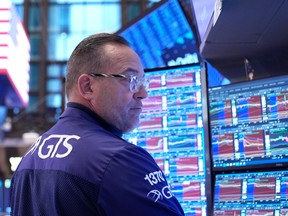
Article content
Stocks in the U.S. seem unstoppable but investors shouldn’t be complacent because there are a number of markers suggesting the rally is more fragile than it seems.
THIS CONTENT IS RESERVED FOR SUBSCRIBERS ONLY
Subscribe now to read the latest news in your city and across Canada.
- Exclusive articles from Barbara Shecter, Joe O'Connor, Gabriel Friedman, and others.
- Daily content from Financial Times, the world's leading global business publication.
- Unlimited online access to read articles from Financial Post, National Post and 15 news sites across Canada with one account.
- National Post ePaper, an electronic replica of the print edition to view on any device, share and comment on.
- Daily puzzles, including the New York Times Crossword.
SUBSCRIBE TO UNLOCK MORE ARTICLES
Subscribe now to read the latest news in your city and across Canada.
- Exclusive articles from Barbara Shecter, Joe O'Connor, Gabriel Friedman and others.
- Daily content from Financial Times, the world's leading global business publication.
- Unlimited online access to read articles from Financial Post, National Post and 15 news sites across Canada with one account.
- National Post ePaper, an electronic replica of the print edition to view on any device, share and comment on.
- Daily puzzles, including the New York Times Crossword.
REGISTER / SIGN IN TO UNLOCK MORE ARTICLES
Create an account or sign in to continue with your reading experience.
- Access articles from across Canada with one account.
- Share your thoughts and join the conversation in the comments.
- Enjoy additional articles per month.
- Get email updates from your favourite authors.
THIS ARTICLE IS FREE TO READ REGISTER TO UNLOCK.
Create an account or sign in to continue with your reading experience.
- Access articles from across Canada with one account
- Share your thoughts and join the conversation in the comments
- Enjoy additional articles per month
- Get email updates from your favourite authors
Sign In or Create an Account
or
Article content
It’s been a roller coaster year for markets. We’ve had tariff wars, actual wars, concerns about the weaponization of the dollar, an artificial-intelligence spending boom and some high-profile bankruptcies, or “cockroaches” in the memorable phraseology of JPMorgan Chase & Co. chief executive Jamie Dimon. Yet despite the turmoil, stocks are very near all-time highs.
Article content
Article content
Article content
Not only that, from a longer-term perspective, the rise in stocks is becoming parabolic. To any investor seasoned in markets before crypto’s time – where so-called HODL-ers fear little from near-vertical market moves – that’s typically a warning sign.
Article content
By signing up you consent to receive the above newsletter from Postmedia Network Inc.
Article content
However, picking market tops is a mug’s game. Unlike market bottoms, which tend to be dramatic and V-shaped, tops are a longer-term process that can unfold over many months. But that doesn’t mean there aren’t signs that a top is forming, and that investors should start to be a little more fearful of the rally – or at least skeptical – and less greedy.
Article content
And there are several reasons to be so inclined. Let’s start with something very unusual, related to technicals. These are a way of analyzing the stock market and its constituents to gauge whether it is overbought, and therefore more likely to correct lower, or oversold and perhaps ready to deliver a strong bounce.
Article content
A “negative divergence” is when a technical study is telling us the overall health of the stock market is deteriorating even as the price increases, which can be a bad omen. The number of stocks in the S&P 500 Index making a new one-year low has been rising even as the market was rallying. In fact, this divergence has reached an extreme never seen before.
Article content
Article content
The previous times when this happened were before the S&P 500 corrected in 1998, and not long before the major market top in March 2000, when the tech bubble burst. With AI companies spending hand over fist on data centres, it’s far from inconceivable we’re nearing the threshold of another tech bust.
Article content
Read More
Article content
And the fall could be steep. Valuations don’t tell you when the market will fall but they can give a good indication of how far it will eventually fall. A blended average of several valuation metrics for the U.S. stock market is at a record high in data going back over 100 years. If the market could drop 30 per cent to 50 per cent as it has on other occasions when valuations were exceptionally high, that does not give one investing in equities today great confidence.
Article content
Valuations are also becoming high in a very real sense. The number of hours that need to be worked, based on average earnings, to buy one contract of the S&P 500 index has jumped to more than 200. That was only 140 hours on the eve of the pandemic and not much above 100 hours at the market top in 2000, which preceded a fall of more than 50 per cent over the next two years.

.jpg) 1 hour ago
2
1 hour ago
2


 English (US)
English (US)